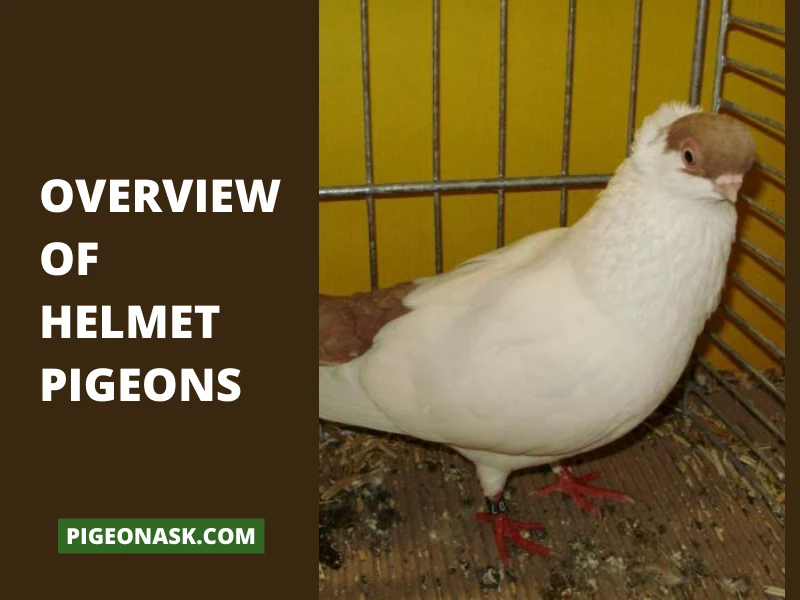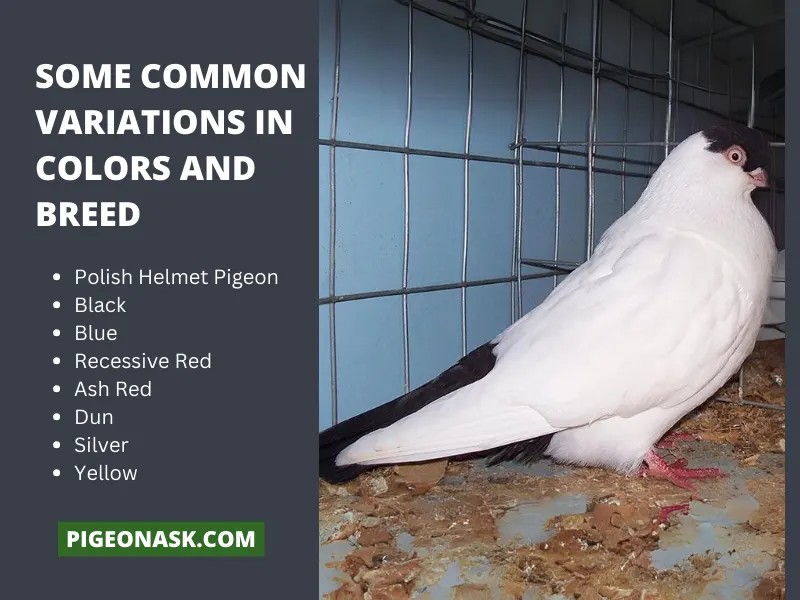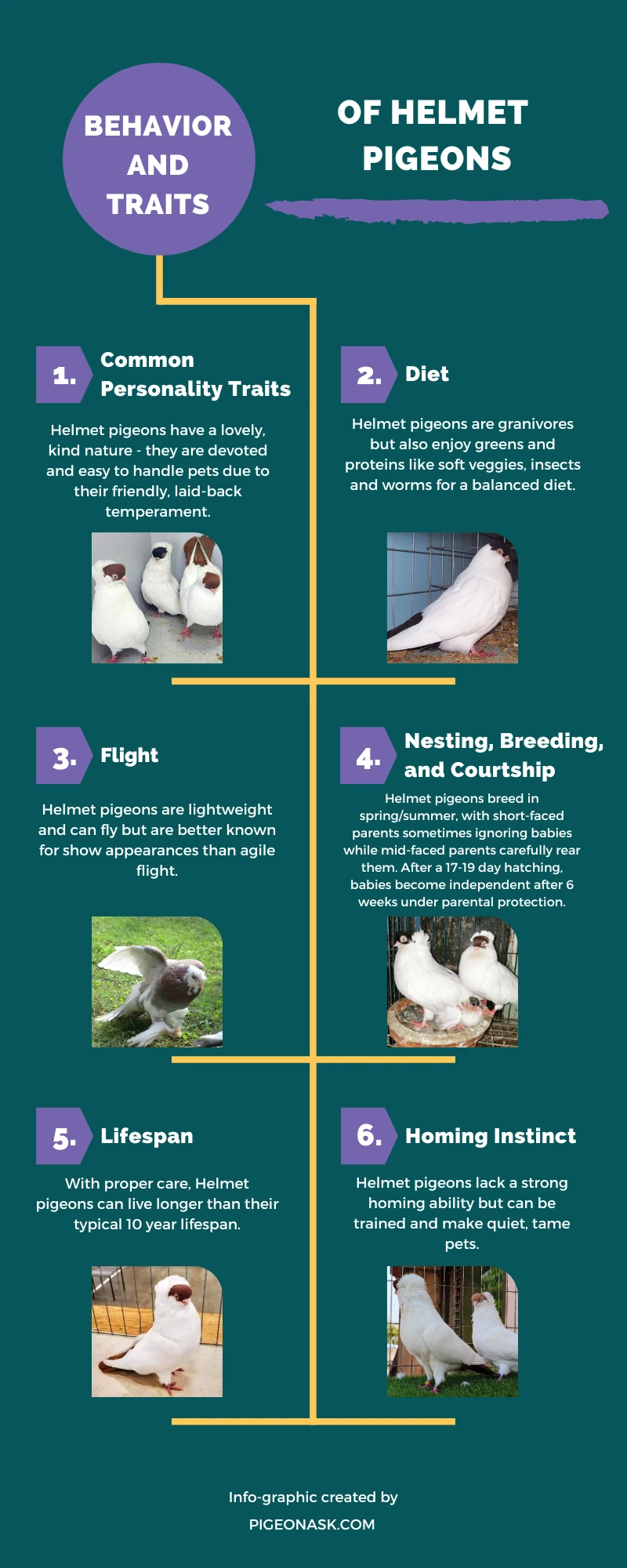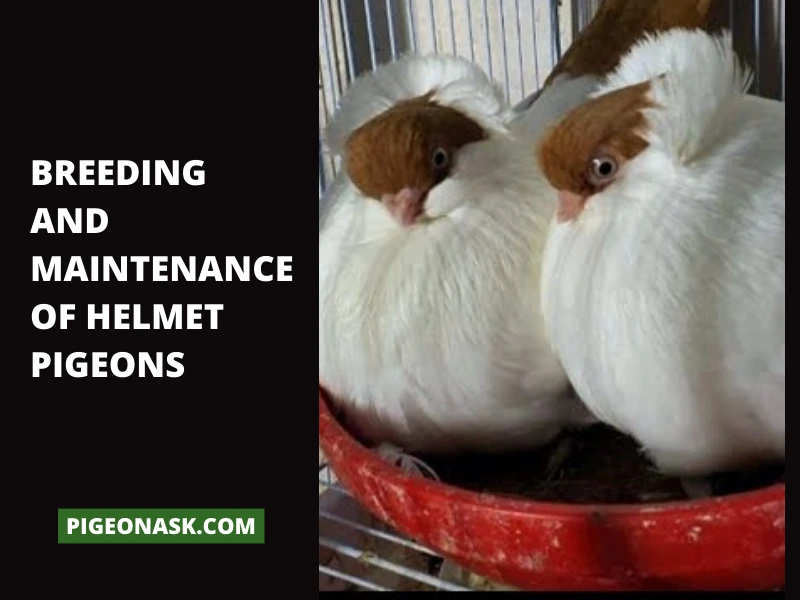Helmet Pigeons: Overview And Breed Guide
In the world of fancy pigeons, where colors, patterns, and plumage often steal the spotlight, the Helmet Pigeon, a true avian beauty, stands out in its delightful way.
Because of the eye-catching helmet-like head shape, it has created hype among pigeon enthusiasts for years now.
While they are mainly bred for show and ornamental purposes, you can have them as amazing pets as well.
Curious to know more about this beautiful bird’s history, how to breed, take care of, and more? Then, stay with us for the rest of the article. Let’s explore the remarkable avian world of the Helmet Pigeon together.
Helmet Pigeon Profile
| Name | Helmet Pigeon Information’s |
|---|---|
| Scientific Name | |
| Common Names | |
| Origin | |
| Size | |
| Weight | |
| Lifespan | |
| Physical Features | |
| Temperament | |
| Behavior | |
| Special Features | |
| Breeding and Maintenance | |
| Common or Popular Varieties |
Interested in similar topics on pigeon breed:
Overview Of Helmet Pigeons
The helmet pigeon is a domesticated fancy pigeon also known by the name of German Helmet Pigeon and Helmet Crested Pigeon. The other names came from its unique head appearance and the place of its origination.

These adorable birds are a result of many years of selective breeding, especially bred for exhibition and ornamental purposes. But now, for their amazing approachable behavior, pigeon lovers nurture them as pets.
Just like other domestic breeds, the Helmet pigeon is also a descendant of feral or wild Rock Pigeon (Columba livia). While these pigeons are pretty identical to the Nun Pigeon, the color pattern is a little bit different in the crest.
History And Origins of Helmet Pigeons
The proper origination place of Helmet pigeons is unknown. However, it is likely to have originated in Persia in the 1500s. Later on, in the 1700s, it became a renowned breed in Germany.

Talking about its development, in the early 20th century, the Helmet Pigeon was imported to the USA. The development of this breed started after a group of fancy breeders formed the American Helmet Association in 1958.
The development process was done by two groups of breeders. The short-faced helmet was developed by the East Coast breeders, while the West Coast (especially in California) focused on the Medium-faced.
Medium-faced ones had strong flying ability, but after the 1970s, they were scoured by the breeders to make them more of a show bird. Nowadays, these amazing birdies are popular all over the world.
Physical Characteristics And Features
The Helmet Pigeon maintains a comfortable and lightweight physique. You can find them from small to medium sizes. Most individuals weigh around 350 grams or 12.3 ounces.
However, let’s take a closer look at their characteristics and other unique features.

Appearance
When it comes to avian elegance, the Helmet pigeon will amaze you for sure. With a striking contrast between the head and body, this bird holds a unique posture while walking.
Its most captivating feature is, of course, its ‘Helmet,’ which resembles a fashionable feathered cap.
The feathers around the head also give it a regal and crown-like appearance. And it captures the attention of anyone lucky enough to spot this bird.
Size and Body Structure
The Helmet pigeon possesses a well-proportioned, slender body with a smooth chest. Their body length typically ranges from 17 to 20 centimeters.
The head of this breed is well-rounded and there is no flatness present. This particular rounded shape is pretty similar to the look of wearing a helmet.
They have a medium-length neck with a prominent crest. The crest is perfectly blended with the neck with no break point and flows down smoothly, enhancing the shape of the head.
And the wings of the Helmet pigeon are close to the body. Plus, they have a beautiful narrow, straight, and neat tail with sturdy legs that are usually free of feathers.
Usually, their tails are packed with 12 feathers, but it can vary depending on the age of the pigeon.
Unique Features
The most unique and captivating feature of this pigeon is, obviously, the helmet-shaped head with crest-like feathers around it.
Typically, the head and tails possess the same colors like black, blue, brown, purple, yellow, etc and the body is mostly white.
The crown may sometimes offer a level of protection against the elements while adding a touch of avian sophistication.
Some Common Variations in Colors and Breed
There are several variations among the Helmet Pigeons depending on the colors and breeds. In most cases, the head and tail have a different color from the body.

Let’s take a gander at the varieties.
Polish Helmet Pigeon: This breed is a close ancestor of the Helmet Pigeon, originated from Poland, also known as the Polish Krymka Tumbler or Krymka Polska. The presence of large feathers on the feet sets it apart from the regular Helmet pigeon breed.
- Black: As the name suggests, the Black Helmet Pigeon is characterized by its dark, coal-black helmet. This velvety headgear sets it apart from its counterparts.
- Blue: True to its name, the Blue Helmet Pigeon showcases a captivating sapphire-hued headpiece that’s impossible to ignore.
- Recessive Red: These pigeons sport a fascinating recessive red helmet, creating a warm and unique contrast.
- Ash Red: The Ash Red Helmet Pigeon boasts a more muted red helmet that resembles the subtle beauty of ash.
- Dun: The Dun ones display a sandy-brown or fawn-colored helmet, which gives them a natural and earthy charm.
- Silver: With silvery, almost metallic headgear and a shimmering crown, silver ones are amazing to look at.
- Yellow: These pigeons don a sunny and radiant yellow helmet, which looks like a bright morning sun. It’s a burst of color against their white backdrop.
Distribution And Habitat
As the Helmet pigeon is a domesticated breed, you will often find them in human-controlled environments. But there are always some questions like how do they interact in the rural settings and what are their habitual preferences?

Geographical Distribution
These pigeons primarily hail from Germany. But later on, it was imported to the USA and developed by a group of breeders. Nowadays, its influence has extended beyond its homeland.
You can find them wherever pigeon lover exists. To be more specific, they are mostly found in the United States, Canada, Australia, the Netherlands, the UK, and Europe.
Habitual Preferences
You see, the helmet pigeon is a home-breed. They thrive in captivating. So, pigeon fanciers keep them in a well-maintained aviary or loft where there is proper access to clean water, a consistent food source, and some essential nesting arrangements.
Urban and Rural Habitats
Pigeons have great adaptability and the helmet breed is no different. They can live both in rural and urban settings. But you will mostly spot them in the urban or suburban areas.
Pigeons have great adaptability and the helmet breed is no different. They can live both in rural and urban settings. But you will mostly spot them in the urban or suburban areas.
Because they were originally bred for show purposes in close proximity to humans
Pigeon lovers who appreciate their appearance and beauty keep them in the backyard aviaries of their houses or on the rooftops with proper accession to food, shelter, and other essential facilities.
Conversely, in the rural areas, you may find them in big aviaries on private properties.
Migration and Seasonal Movements
As the Helmet pigeon is specifically bred as a domestic breed, they do not engage in any migration or seasonal movements. They are raised in captivity and remain confined in the lofts or aviaries throughout the year.
Threats and Conservation Status
As these pigeons are found in larger quantities and common in rarity, they are not endangered or threatened species.
Yet, they are vulnerable like other domestic breeds. Diseases and parasites can cause fatal illnesses to them. Plus, predation is another concern if you do not provide proper shelter and security.
To keep them healthy and happy, you must practice responsible breeding and provide proper care.
Behavior And Traits of Helmet Pigeons
In this section, we’ve discussed the Hemet pigeons’ typical personalities and behaviors.

Common Personality Traits
These birds possess a lovely and kind nature. They are typically modest and polite. If you treat them well, they will continue to be devoted to you.
You may keep Helmet pigeons without worrying because they don’t act aggressively and get along with various breeds in the lofts.
This approachable and friendly manner makes them easier to handle. Plus, their laid-back temperament is an advantage if you plan to breed them as pets.
Diet
Just like any other fancy pigeon species, the Helmet pigeons are granivores. They like to munch on grains, seeds, and pellets.
But, to offer a more balanced diet, you can add green veggies and protein options to their regular dietary plan. Veggies that are more likely to be soft and easier to munch on are the most preferable ones.
Vegetables like lettuce, cabbage, cauliflower, kale, broccoli, and spinach are amazing options. Remember to chop them into more manageable sizes so that your pigeon can digest them easily.
To ensure protein, add small insects and worms to their diet sometimes.
Flight
While these pigeons are lightweight and are capable of flight, they typically do not engage in long-distance flight. They are mostly well-known for their showing capabilities.
Their unique head shape, crest-like feather, slender body, and overall gorgeous stance are more appropriate for posing in the show arena rather than agile flight.
Nesting, Breeding, and Courtship
Regarding the breeding process, the Helmet pigeons can be bred easily as they are naturally good breeders.
Generally, the breeding takes place during the early spring and summer. Why is that? Because at this time, the sun remains mostly in the sky, providing enough natural light for a significant amount of time than other seasons.
Now, an interesting fact is that short-faced Helmet pigeons are sometimes indifferent to their kids. So, breeders foster them in this case.
On the other hand, mid-faced Helmet pigeons are devoted to their kids and rear them with careful attention.
However, in the meeting season, when they pair up, they start to build their nest. In this situation, you can assist them by providing nesting materials like hay, straws, and twigs.
Plus, you must ensure sufficient space in the aviaries for each pair to increase their mobility and nesting efficiency. After the pigeons complete their nesting, the mama pigeon lays 2-3 eggs per year.
The whole hatching process takes around 17 to 19 days and it can be delayed depending on elements like weather, temperature, and so on.
And the adorable baby pigeons become independent and start to live on their own after 6 weeks of hatching. However, their parents still keep a keen eye on them and always look for any potential danger.
Lifespan
The Helmet pigeon typically lives around 10 years. Yet, if you provide proper care, regular health checkups, nourishment, and other essential facilities, they can live longer than their regular lifespan.
Homing Instinct
The Helmet pigeons might not have a strong homing instinct like the racing pigeon breed. But you will be surprised with the result if you train them a little bit.
Because of this particular instinct and tame nature, Helmet pigeons can make amazing pets. Also, they hardly make noise, so you don’t have to be worried about your neighbors getting disturbed.
Breeding And Maintenance
Now, to breed them successfully, you have to pay proper attention to every single detail. Check out the following instructions carefully.

Information about Raising and Breeding
Successful breeding highly depends on time. In summer and spring, when the weather remains warm, you can start your breeding practices.
Then, to have your desired pigeons, always select a compatible and healthy pair of pigeon parents who have all the characteristics that you are looking for.
This is because the overall quality, appearance, immune system, and health of the offspring depends on its parents genetics. Healthy parents mean healthy babies.
Don’t forget to provide nesting boxes or a platform with enough space. Make sure they are filled with all the nesting materials that your pigeon might need.
For additional safety, disinfect the nest regularly; this will prevent any kind of virus, parasites, or disease spread.
Some Tips and Considerations for Successful Breeding
You know, the breeding practices can be an amazing experience if you do it in the right way. Here are some essential tips to make it more effective –
- Check your pigeon’s health regularly and keep a record.
- As during the breeding time, the pigeons need more nutrients to provide a balanced diet consisting of vitamins, minerals, fat, protein, and carbohydrates.
- Temperature and humidity levels are pretty important, so keep the temperature between 98.6°F to 100.4°F.
- You must reduce disturbances during nesting and incubation.
- To monitor their development, maintain a record of their hatching and breeding dates.
- Remain prepared for any foreseeable difficulties, such as harsh weather and health problems.
Feeding and Housing Requirements
Your Helmet pigeons’ housing and food needs must be met if you want to keep them to be healthier. With access to wholesome food and good water sources, you need to feed them twice daily with a nourishing diet.
Their daily diet must include seeds, grains, veggies, and fruits like berries. Once in the morning and once in the evening.
You can keep the proportion 50/50. 50% of quality pellets, seeds, and grains, and the same amounts of chopped veggies and fruits. Also, water should be available consistently and twice daily at the very least.
To avoid contamination, keep a close check on their eating habits and frequently replace the water and food containers.
Regarding habitat, you must provide them with a loft or aviary with plenty of perching area so they can expand their wings quietly.
For a breeding pair, arrange nesting boxes or platforms. That’s how they will remain safe and sound from other companies.
Finally, take care of the ventilation and keep the temperature at a suitable level in the aviary because too much warmness or coldness will hamper your healthy breeding practices and your pigeons.
Final Words
In a nutshell, Helmet pigeons are the excellent characters of the avian world with their distinct personalities, headgear, and overall look. They are a gentle reminder of nature’s delightful surprise.
These adorable pigeons have shown us that diversity has no bounds, even in the avian kingdom. So, whether you are a pigeon enthusiast or breeder, you can have the Helmet pigeon as your show champion or an amazing pet.
That’s a wrap for today. Hopefully, you have your feedback. If you found this article beneficial, please feel free to share it with your close ones and follow us on our socials Facebook, Twitter, Google News.
